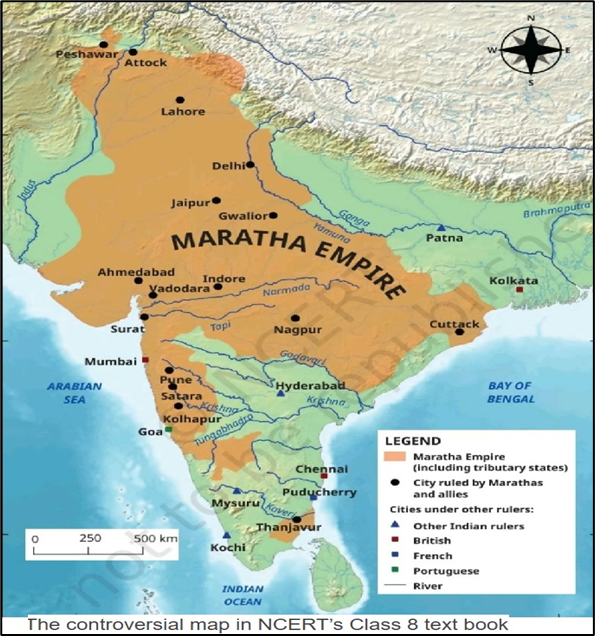Why in news?
A controversy has erupted over a map in the new NCERT Class 8 social science textbook showing Jaisalmer as part of the Maratha empire in 1759.

Relatives of the former Jaisalmer royal family, called the depiction “historically misleading” and “factually baseless,”. They stated that no authentic records indicate Maratha control, invasion, taxation, or authority over Jaisalmer, and that royal archives confirm the Marathas never interfered in the princely state’s affairs.
Responding to the objection, the chairperson of NCERT’s curricular area group for social science, said further research is underway to verify the map’s accuracy, and if errors are found, a corrected version will be prepared for future editions.
What’s in Today’s Article?
- Northern Expansion of the Marathas: Economic Tribute vs. Political Control
- Historians Confirm Jaisalmer Was Never Part of the Maratha Empire
- Maratha Empire: Patchy Control and Varied Authority
- NCERT Responds to Map Controversy, Open to Revisions
Northern Expansion of the Marathas: Economic Tribute vs. Political Control
- In the early 18th century, as the Mughal empire fragmented, Peshwa Baji Rao I led Maratha expansion into northern regions, including parts of Rajasthan, Delhi, Punjab, Bundelkhand, Orissa, Bengal, and Bihar, consolidating control over Malwa after the Battle of Bhopal.
- Historians state that the Marathas often allowed local rulers to remain in power, securing agreements with zamindars to collect tribute rather than replacing them.
- They clarified that while the Marathas collected chauth and sardeshmukhi from Rajput territories and other regions, this did not always translate into political dominance, as many states paid tribute without recognizing the Peshwa as their sovereign.
Historians Confirm Jaisalmer Was Never Part of the Maratha Empire
- Historians agree that while the Marathas expanded northwards after consolidating power in the Deccan, annexing regions like Malwa and Orissa and extracting tribute from several Rajput states, Jaisalmer was never under their control.
- According to them, the Marathas entered Rajasthan—often at the invitation of Rajput chiefs to resolve succession disputes—and confined most raids to Jaipur and Jodhpur, never targeting Jaisalmer or Bikaner.
- There is no historical evidence of Jaisalmer being a tributary state. Maratha expeditions in Rajasthan to claim tribute, but with no lasting administration, as local rulers often expelled Maratha agents once the armies left.
- Even prominent states like Amber-Jaipur failed to pay tribute regularly, and there is no record of Jaisalmer making such payments, reinforcing that it was never part of the Maratha empire.
Maratha Empire: Patchy Control and Varied Authority
- Historians note that Maratha rule in the 18th century was far from uniform.
- They described it as “patchy and irregular” between the 1730s and 1750s—ranging from fully administered territories to areas only loosely controlled, where resistant zamindars defied authority.
- Historians observed that the Maratha polity has often been framed as a regional awakening, a Hindu reaction to Muslim rule, or an effort to reform Hindu society.
- They argued that it should instead be seen as one of many contemporary polities, not a proto-nationalist crusade.
- While the Marathas claimed sovereignty over large parts of India, their actual control varied greatly, and the more important question is understanding how authority was established rather than glorifying dynastic territorial claims.
NCERT Responds to Map Controversy, Open to Revisions
- NCERT clarified that the new Class 8 social science chapter on the Marathas was prepared with expert consultation and based on earlier published maps, with no prior objections.
- The map includes areas under direct Maratha control as well as tributary states or regions under temporary agreements.
- NCERT acknowledged that a disclaimer on approximate borders, present in the Grade 7 book, should also have been included in Grade 8.
- Experts suggested using different shades on maps to distinguish direct control, tributary states, short-term conquests, and areas of influence, as a single colour oversimplifies history.









